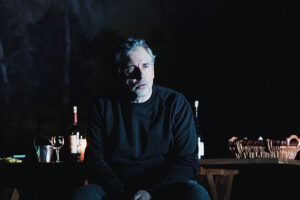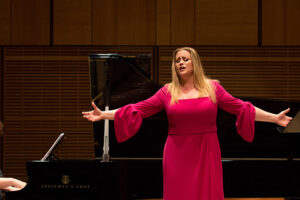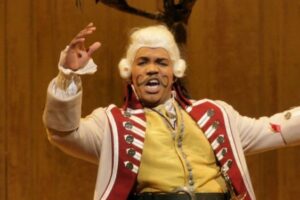

Sifting through Zweig’s charming collection of memories, one can find humor in the mania audiences expressed over the fading bars of a Beethoven quartet, or the peculiar way its citizenry would collectively mourn the closure of a concert hall or the passing of a great stage artist.
As Zweig famously wrote of his city, “The Minister-President or the richest magnate could walk the streets of Vienna without anyone turning around, but a court actor or an opera singer was recognized by every salesgirl and every cabdriver.”
If modern day Vienna has acquired a more cosmopolitan flavor, the centrality of opera to Viennese life and thought appears to have remained largely frozen in time. Vienna’s Staatsoper, which celebrated its sesquicentenary this past spring, continues to be an active cultural focal spot for a public that accords celebrity status to its favorite singers.
Sensationally cast productions like its recent staging of Die Frau Ohne Schatten can incite Stehplatz devotees to begin camping out for tickets as early as mid-morning. And paralleling Zweig’s own recollections, the most passionate opera fanatics will congregate post-curtain to debate the virtues of a contemporary vocalist’s art against the high bar set by beloved past legends.
Adding to these celebrations, the Staatsoper has also authorized the release of audio (Orfeo) and video (Arthaus Musik) collections of operas that uphold its legacy as one of the world’s greatest purveyors of the art form.
In collaboration with ORF (the Austrian Broadcasting Corporation), the German classical label Orfeo has curated nine complete sets of live opera and a compilation of excerpts from the Staatsoper’s archives into a special box released exclusively for this historic milestone.
Orfeo’s 150 Years box chronologically documents some of the finest nights of live opera from the Wiener Staatsoper in the years following its restoration in 1955. All of the operas are cast with exceptional vocalists and are presided over by conductors who are deeply sympathetic to the composers’ music.
The first half are sourced from the years immediately following the house’s reopening, and the remainder are contemporary broadcasts that demonstrate Vienna’s unbroken tradition of attracting stellar talent.
The first four operas in this box span the period coinciding with postwar tenures of Karl Böhm and Herbert von Karajan. Each of these legendary Austrian maestros are given two sets originating between the mid-50s to the late 70s. First to appear is Böhm’s 1955 Wozzeck, followed by Karajan’s Fidelio from 1962 that had previously been released on Deutsche Grammophon.
Wozzeck (previously released on Andante) fascinates for documenting the orchestral reading of one of the composer’s greatest champions and for depicting the German music world’s more theatrically driven (e.g. more emphasis on the sprech side of sprechstimme) philosophy on performing Berg’s music during those years.
Most listeners familiar with Böhm’s Wozzeck know the studio recording from the Deutsche Oper Berlin with Dietrich Fischer-Dieskau and Evelyn Lear.
By the time the conductor committed this difficult opera to record, the approach to singing Berg had adopted a greater degree of musicality and accuracy that once eluded musicians. The live performance from 1955 features excellent singing and acting from the leads Walter Berry and Christel Gotz. The other principals, though appropriately characterful in the Wagnerian Mime mould, do not exhibit the same level of polish in addressing Berg’s vocal lines.
Prior to acquiring this box, I learned of Böhm’s interpretation from the Andante set and absorbed much about Wozzeck’s character through Berry’s excellently sung interpretation.
But there exist other great performances of Berg in the Staatsoper archive—namely, the critically acclaimed Abbado recording on DG, and a now out-of-print Lulu that marked the first time the Viennese experienced the opera’s full three-act version, recorded during Lorin Maazel’s blink-and-you’ll-miss tenure with the Staatsoper.
As greatly as I enjoyed the musical contributions from Böhm’s 1955 team, I feel that Maazel’s Lulu showcases a musically and theatrically superior performance of Berg during a time when the musicians and singers had more or less reconciled with the composer’s challenging idiom.
Karajan’s Fidelio from 1962, starring Christa Ludwig as Beethoven’s noble creation, was previously released on DG. This supposedly star-studded recording achieved notoriety during its release as the covers promised Jon Vickers’ haunted Florestan beside Ludwig’s Leonore—a pairing that when combined with the 1960s Karajan’s more exciting conducting ought to make this a collector’s favorite.
Alas, the cataloguers in Orfeo failed to notice DG’s glaring error, and still associate Vickers’ name with a tenor whose vocal color and phrasing style is patently not his. Vickers was supposedly under the weather when this performance was broadcast, but I doubt that any amount of congestion or viral fry would cause a tenor with a timbre and artistry as distinctive as Vickers to transform into a singer devoid of those idiosyncratic qualities.
Hans Beirer was supposedly the tenor captured in this performance, and even now in this compilation the poor singer wasn’t correctly acknowledged.
Ultimately, even if this Fidelio might have been an exciting evening at the theater, there is little about it that isn’t bettered by other competing recordings. The orchestral execution at times could sound scrappy and indifferent, and the ensembles aren’t nearly as clean.
Vickers and Ludwig are heard to greater effect in Otto Klemperer’s legendary studio record, and Karajan’s direction in this score is more nuanced in his EMI recording from nearly a decade later.
Had I been placed in charge of compiling this box, I would have remastered the significantly more potent Fidelio conducted by Leonard Bernstein with Gwyneth Jones and James King–surely one of the greatest Fidelios captured on tape (Jones in my opinion is also a superior Leonore to Ludwig, and when inspired by Bernstein could bring the opera’s artistic values to stratospheric heights).
If a Karajan performance were a necessity, I would have licensed the 1964 Die Frau Ohne Schatten featuring Gundula Janowitz, Jess Thomas, Grace Hoffman, Christa Ludwig, Walter Berry, and Lucia Popp. Although Karajan’s peculiar feng shui rearrangement of the score may bewilder some, it presents listeners with the rare opportunity to hear a nonpareil Straussian like Karajan in this incredible score with a festival quality cast.
The next opera is an unequivocal triumph from ORF’s broadcast archives. Böhm’s 1965 Elektra (production by Wieland Wagner) presents us with one of Birgit Nilsson’s first attempts at the role of Elektra, and what a searing performance it is!
If you don’t already own Orfeo’s individual release of this recording, this box allows you to sample Nilsson’s finest, most vocally fresh take on Elektra alongside a cast that includes Rysnanek’s orgasmic Chrysothemis, Eberhard Waechter’s refulgent and characterful Orest, Regina Resnik’s vibrant Klytämnestra, and Wolfgang Windgassen’s heldentenor Aegisth.
Combined with Böhm’s intensely dramatic yet gracefully filigreed orchestral reading, this Elektra perhaps represents Nilsson’s finest recorded assumption of the role.
Karajan’s 1977 Le Nozze di Figaro, also present in Orfeo’s catalogue, is the last of the recordings in this box that features two of the Staatsoper’s legendary Austrian maestros. This Figaro is virtually a carbon copy of the lavishly cast (Tomowa-Sintow as Contessa, Cotrubas as Susanna, Van Dam as Figaro, Krause as Almaviva, and von Stade as Cherubino) Decca recording that was maligned by critics for its turgid, lifeless conducting.
Unlike the studio effort, Karajan here turns out a reading of great vitality, more fleeting compared with the carefully massaged product more familiar to the public. The elegance of phrasing and beauty of sound he coaxes from the Staatsoper orchestra almost reminds one of his theatrically propulsive interpretations from the 1960s.
And the singing is truly a banquet of great, big house Mozartean voices, the vocalists’ interpretations coruscating and flickering in a way that is absent from the recording studio. The most notable singers: Tomowa-Sintow’s ravishing Countess, Contrubas’ charming and lovely Susanna, and Tom Krause’s suave, powerful Count.
The remainder of the opera performances in this set are new releases that are seeing their first incarnation on an officially released disc. We’ll take a look at them tomorrow.























Comments